Deohap Dry: Biomimetic hydroxyapatite for sweat control (Deodorant)
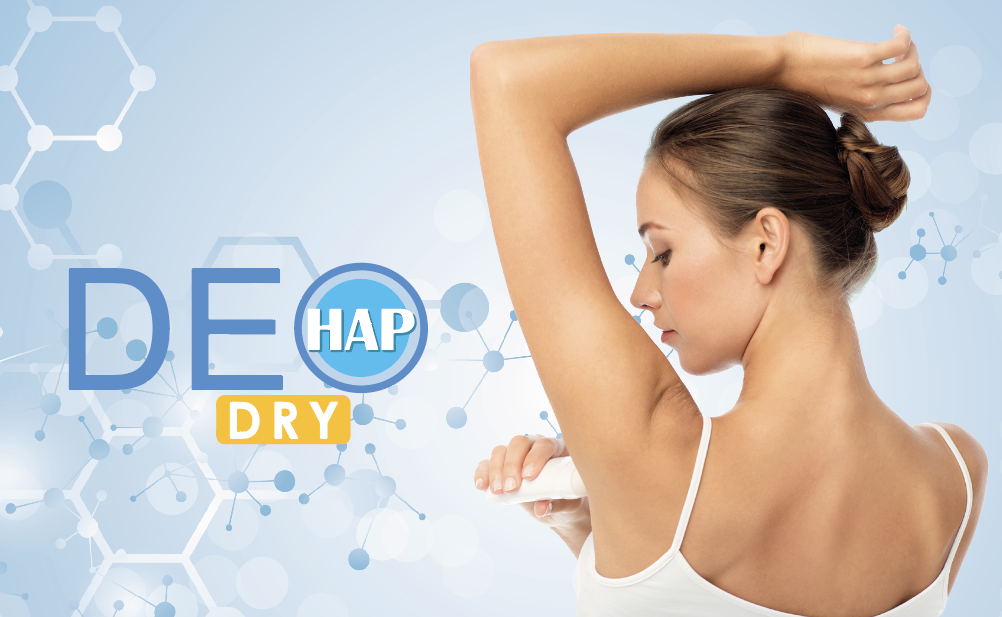
13 March 2025
Introduction
The current landscape of sweat and body odour control products typically relies on traditional active ingredients like aluminium chloride or aluminium chlorohydrate-based salts. Although very effective in reducing sweating, these compounds may release at different amounts hydrochloric acid, which can lead to undesired side effects on the skin.
Firstly, hydrochloric acid can irritate the skin, reducing the product’s skin tolerance and user compliance.
Moreover, formulas containing aluminium-based salts such as chloride or chlorohydrate, and aluminium/zirconium chlorohydrate are not always so accepted.In recent times, issues related to environmental impact of aluminium salts as well as skin health and irritation are posing concerns in the use of these ingredients.Moreover, by lowering the pH it can disrupt the skin’s microbiota.
Additionally, the mechanism of action of these salts—based on the obstruction of sweat ducts—may cause functional damage to sweat glands and impair the physiological perspiration process.
To address these issues associated with conventional approaches, Kalichem developed a new ingredient based on a patented technology. The speciality, named Deohap Dry (main active and excipients INCI: Calcium/Magnesium/Zinc Hydroxyapatite, clay minerals, zinc PCA; hereafter described as the HAP complex), has been specifically designed to be gentle, effective and ideal to be used in various formulation systems.
The core innovation relies on the biomimetic hydroxyapatite, functionalized with zinc and magnesium ions, to obtain a broad range of beneficial cosmetic effects, such as:
- Odours and sweat adsorption
- Deodorizing
- Bacteriostatic action
- Skin homeostasis
- Microbiota balance
Biomimetic hydroxyapatite is structurally and functionally similar to the naturally occurring form in the human body. It is obtained through an exclusive technology differentiating from stoichiometric hydroxyapatite.
The unique properties of this mineral contribute directly to its effectiveness in reducing body odours and sweat. The high hydration capacity and water affinity of the material enable effective adsorption of sweat. Its rough, porous surface provides a large surface area, enhancing its interaction with sweat components.
Its electrophilic nature enables, furthermore, to trap volatile molecules, thus effectively neutralizing body odours. The substitution of divalent ions such as zinc and magnesium in the hydroxyapatite lattice enhances its electrophilic properties, facilitating stronger interactions with volatile molecules like ammonia, hydrogen sulfide. This enables the mineral to trap malodourous substances, thereby exerting its deodorizing effect.
Sweat control formulation challenges
The actives commonly used in anti-perspirants and deodorants, e.g. aluminium salts, triclosan, natural ingredients including antibacterial extracts, may be included in different cosmetic forms – such as sprays, sticks, roll-ons, aerosols, and creams – but require to be formulated differently for each type to ensure effectiveness, stability and safety.Specific challenges for the fulfillment of each of these factors are following described.
Commonly used salts with anti-perspirant action can be present in sticks, creams, roll-ons, and, under certain conditions, aerosols; nonetheless they require specific and extremely acidic pH values for overall stability and functionality achievement, strongly influencing and limiting the inclusion of other potentially synergistic ingredients.Antibacterial benchmark ingredients can be formulated in both liquid (roll-on or spray) and solid (stick) forms, but the concentration must be tailored to the vehicle to avoid irritation or destabilization.
The vehicle compatibility represents another relevant topic as aerosols require the use of propellants and a highly dispersible formulation, which can influence the choice of active ingredients and their dosage.
Sticks and creams require active ingredients that are compatible with solid or semi-solid bases, often wax or emollient based.Furthermore, skin safety is a leading factor for the ingredients selection, since some ingredients may irritate the skin when applied at high doses in products with high persistence (creams, sticks) compared to sprays or aerosols, which dry out more quickly.
Additional challenges are linked to the sensory perception (sprays must evaporate quickly without leaving residue, which can significantly limit the amount of usable actives).
Deodorizing and skin odour adsorption actives (zeolites, some clays and starch based powders) are critical to be used in aerosol products given the lack of their uniformity in suspension and dispersion phase, gravity or agglomeration, which can cause sedimentation or clogging of the dispenser (compromising the effectiveness of the end product), as well as the sensory perception (adsorbent powders can leave visible residue or an unpleasant dry feeling on the skin, which can be especially noticeable in spray products).
In emulsion systems, stability is the main concern due to deodorizing ingredients tendency to interact with the emulsifiers, leading to final separation (typically occurring with some zeolites or bicarbonates).Emulsions require a careful choice of emulsifiers and stabilizers to incorporate solid actives without compromising the texture or appearance of the product.
pH compatibility (for skin microbiota preservation) and sensory issues (the presence of some adsorbent particles can give a grainy or sticky texture, which is unpleasant for consumers) are other frequent challenges.
Finally, from an overall functional perspective many deodorizing actives show reduced efficiency in extreme conditions (most of them work best in dry environments; heavy sweat can reduce their ability to neutralize odours).
HAP complex benefits
The HAP complex stands out as a multifunctional and effective ingredient, capable of transversally responding to the aforementioned requirements, specifically with its formulation inclusion versatility, its unique sensory profile – especially its ‘invisible’ nature, which makes it peculiar in the context of sweat adsorbent actives – and its effectiveness, regardless of the application format (ranging from sprays, propellent-based aerosol up to oily sticks, pastes and anhydrous systems).
It is available in various forms – both in 30% concentrated water solution and as pure powder – through which it can be integrated into roll-on and spray emulsion forms, in aerosol or emulsion for light and uniform protection, in richer creams for targeted application leading to greater hydration and dermocompatibility and oily stick/paste based forms for more practical and compact waterless solutions.
In Tables 1-4, various formulation system proposals with the HAP complex are shown.
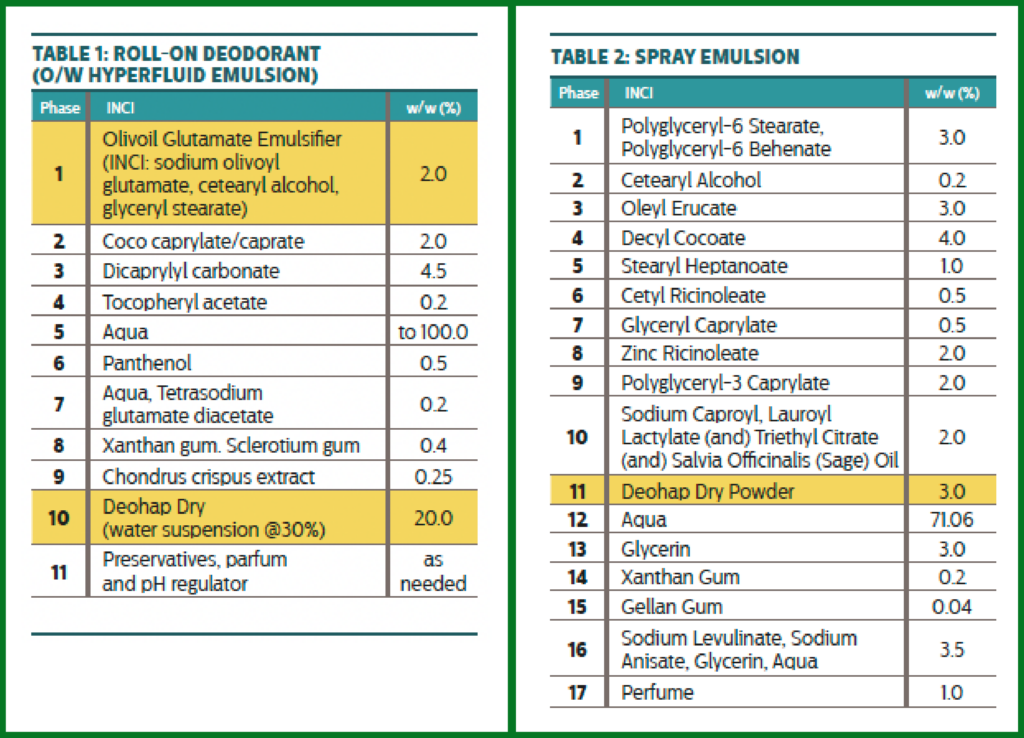
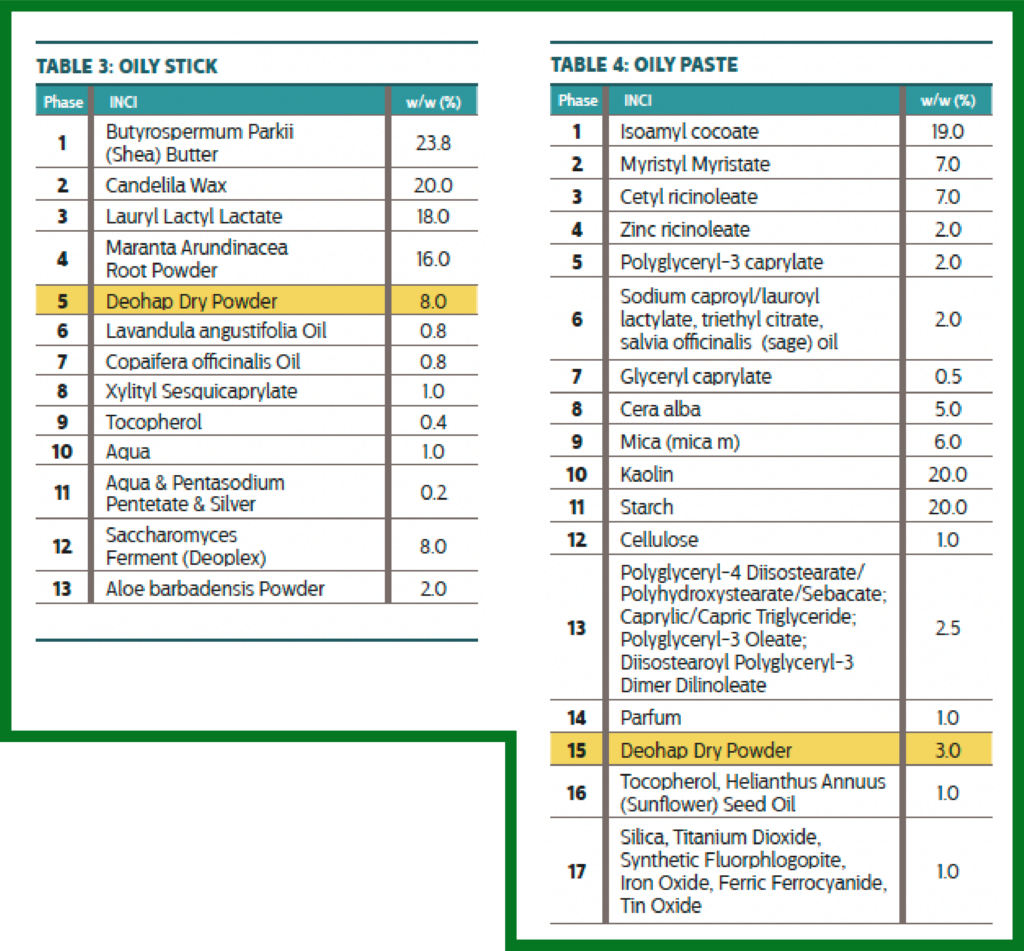
Effectiveness evaluation
The efficacy of the HAP complex was assessed through in vivo and in vitro tests.
In vitro test
The odour adsorption quantification was assessed through an advanced and sophisticated gaseous-phase experimental model. This model enabled the measurement of ingredient’s adsorption capacity for ammonia-based volatile substances, allowing for a comparison with other adsorbent materials.
Briefly, a gaseous mixture containing ammonia was passed through the sample (under conditions similar to physiological ones) and subsequently analyzed by FT-IR spectroscopy to determine its concentration. The decrease in signal intensity over time provided a measure of ammonia adsorption by each sample.
Ammonia concentrations ranging from 80 to 400 ppm were tested. Sweat contains ammonia, along with other compounds like lactate and urea, which are metabolized by bacteria to produce typical body odours. To further assess the HAP complex’s deodorizing efficiency, we tested its adsorption capacity for lactate and urea using an in vitro liquid experimental model based on artificial sweat.
This model was developed in collaboration with the Italian National Research Council. Each sample was mixed with a solution of artificial sweat containing sodium lactate and urea. After centrifugation, the collected powder was analyzed by FT-IR to quantify the amount of lactate and urea adsorbed by each material.
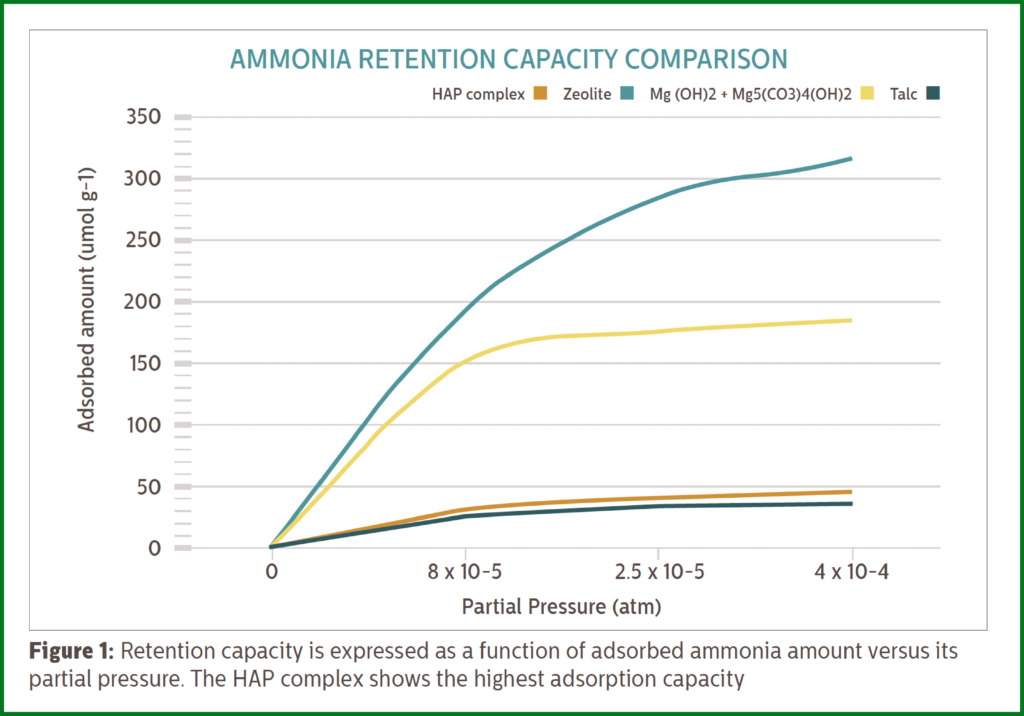
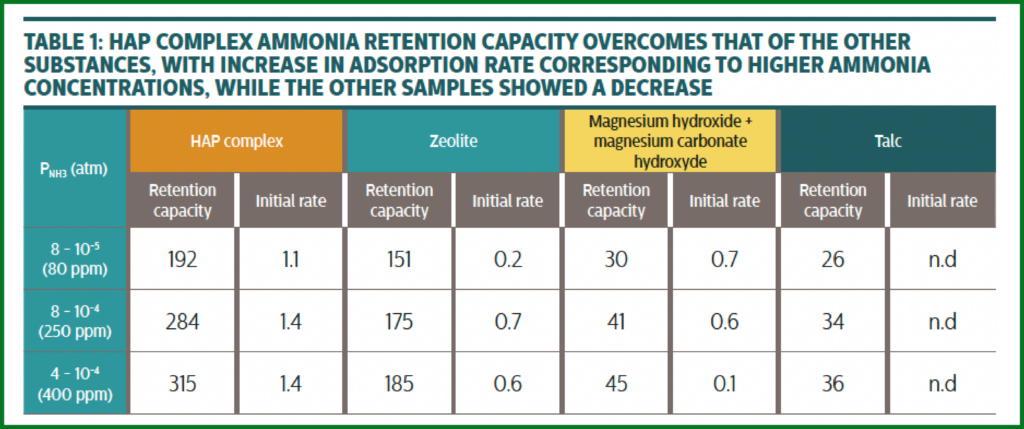
In vivo test
Test formulation with the HAP complex (7% a.m.) was evaluated through gravimetric test, for the experimental determination of a product’s ability to reduce the amount of underarm sweat produced.7
The test was performed on 16 healthy female and male subjects, ages 18 to 65 years. Only those volunteers who produced underarm perspiration levels from normal to high were included in the study. After a 17-day clearance period, during which subjects refrained from applying antiperspirants or deodorants, they applied both test and placebo formulations once daily, four days.
Half of the subjects applied the test o/w emulsion under the left armpit and the placebo under the right armpit, and the other half applied the formulations oppositely. In line with consumer habits, subjects applied 300 mg of each formulation (± 10%). Then, 24 hours and 48 hours after the last daily treatment, subjects were placed in a temperature-controlled room (40°C, RH 30-40%) for a 40-minute warm-up period to induce increased perspiration.
Following this, pre-weighed absorbent pads were placed onto both armpits of each subject, leaving them in the controlled room for an additional 20-minute collection period. Sweat was measured by weighing the absorbent pads again, at the end of the collection period.
No volunteer withdrew from the study and no deviations occurred during testing.
Results
The graph in Figure 1 illustrates the in vitro retention capacity of the HAP complex vs the other samples (zeolite, a mixture of magnesium hydroxide/magnesium carbonate hydroxide and talc) expressed as adsorbed amount versus ammonia partial pressure. Notably, not only did the HAP complex adsorb more ammonia, it also demonstrated a higher adsorption rate.
While the other materials quickly reached saturation and lost their ability to further adsorb ammonia, the HAP complex still retains its adsorbing capacity, thus it continues to adsorb odours as their concentration rises, unlike the other substances, which become quickly saturated. The comparative test results are summarized in Table 6.
The HAP complex’s ability to adsorb components of artificial sweat was tested also in liquid experimental model (artificial sweat) vs other odour-adsorbing substances, including zeolite and the magnesium hydroxide-carbonate hydroxide blend.
The results for lactate adsorption are shown in Figure 2.
The HAP complex demonstrated a higher lactate adsorption capacity than both zeolite and magnesium salts.
Similar results were obtained for urea (data not shown). Based on the results, an order of adsorbent efficiency can be established, as follows: the HAP complex based on substituted biomimetic hydroxyapatite proved to be the most effective adsorbent for the odour components of sweat, followed by zeolite, the magnesium salts and talc.
In vivo
The average amount of sweat collected from test formulation-treated and placebo formulation treated armpits was calculated in terms of grams of sweat at 24 hours and 48 hours after the last daily treatment. The results are summarized in Table 7 and represented in Figure 3.
Mean percent variations in sweating measured in the armpits treated with the test formulation versus the placebo at 24 hours and 48 hours after the last daily treatment are shown in Table 8.
24 hours after the last application, the mean amount of sweat collected from the test formulation-treated armpits was lower by a mean value of 35.5%, compared with the mean amount of sweat collected from the placebo-treated armpits. Statistical analysis performed with the Wilcoxon signed-rank test demonstrated the sweat control efficacy of the test formulation after 24 hours and according to FDA guidelines.
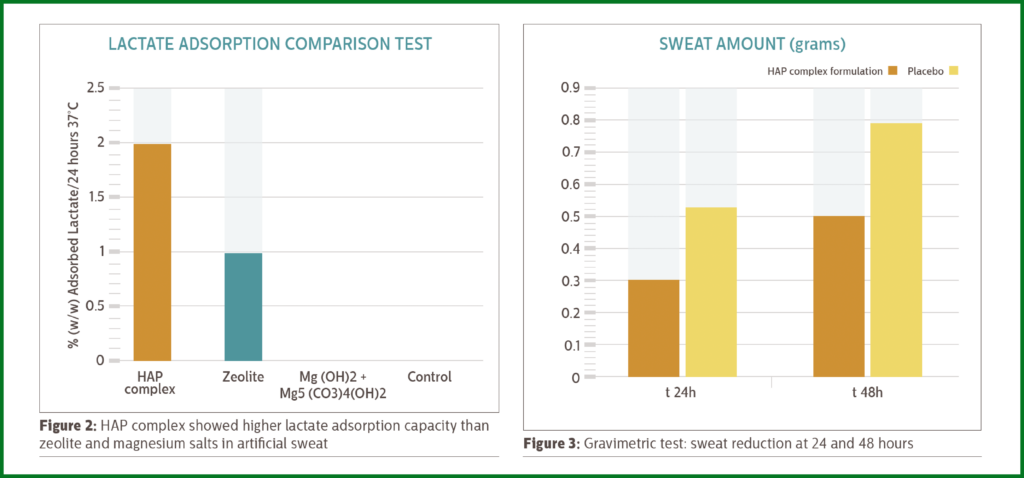
This positive result is attributed to the reduction in sweating having exceeded 20% in at least 50% of the target population (p < 0.05). After 48 hours, the mean amount of sweat collected from the test formulation-treated armpits resulted in a lower mean value of 30.5%, compared with the placebo treatment. Statistical analysis confirmed the sweat control efficacy of the test formulation at 48 hours, again according to FDA guidelines.
Conclusion
In summary, the HAP complex emerges as a groundbreaking solution for sweat and odour control, offering good performance and versatility across various cosmetic applications.
Unlike traditional actives which present issues such as skin irritation, microbiota disruption and pH dependency, the HAP complex addresses these limitations through its biomimetic hydroxyapatite structure. This innovative material ensures effective adsorption of sweat and malodourous compounds, such as ammonia and lactate, while maintaining skin homeostasis and microbiota balance.

The in vitro and in vivo studies underscore the HAP complex’s ability to outperform conventional materials like zeolites and magnesium salts, with demonstrated reductions in sweat and enhanced odour neutralization. Furthermore, its compatibility with a wide range of formulations – from sprays to creams and anhydrous systems – ensures a seamless integration into diverse cosmetic products. The unique sensory profile, characterized by its invisible and non-irritating nature, adds to its consumer appeal.
This multifunctional ingredient not only provides a sustainable alternative to traditional actives but also sets a new standard in deodorizing efficacy, formulation flexibility, and dermo-compatibility. Its adoption could redefine the future of personal care products, aligning high performance with enhanced safety and user comfort.
Ingredients
Formulations
Sweat Control Spray Deodorant
Deodorant spray formulation containing a unique adsorbing, sweat controlling active, based on multi-functionalized Hydroxyapatite. Long lasting action (48h).
Sweat Control Roll-on Deodorant
Deodorant roll-on formulation containing a unique adsorbing, sweat controlling active, based on multi-functionalized Hydroxyapatite. Long lasting action (48h).
Sweat Control Roll on Deodorant
Hyperfluid roll-on emulsion, based on a patented olive oil fatty acid based emulsifier and DEOHAP DRY, a patented smart-deo active based on biomimetic hydroxyapatite.












